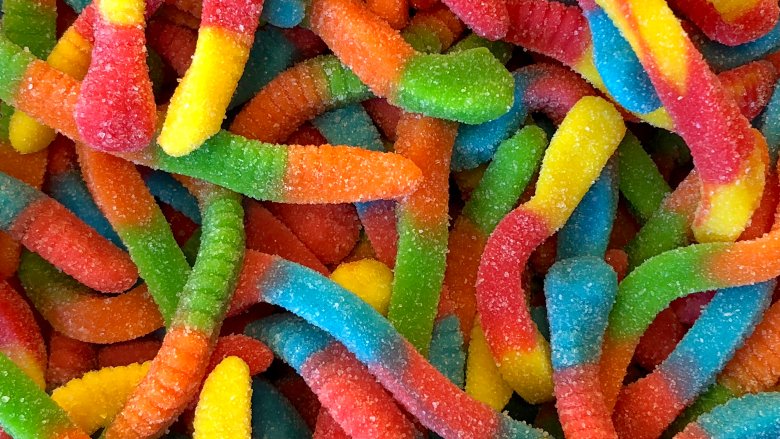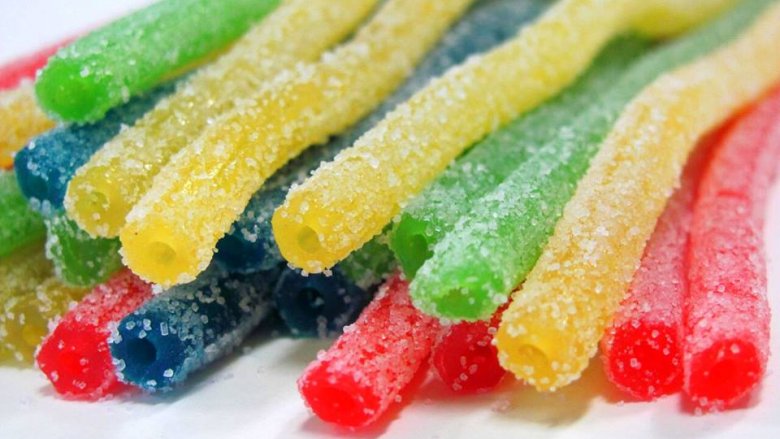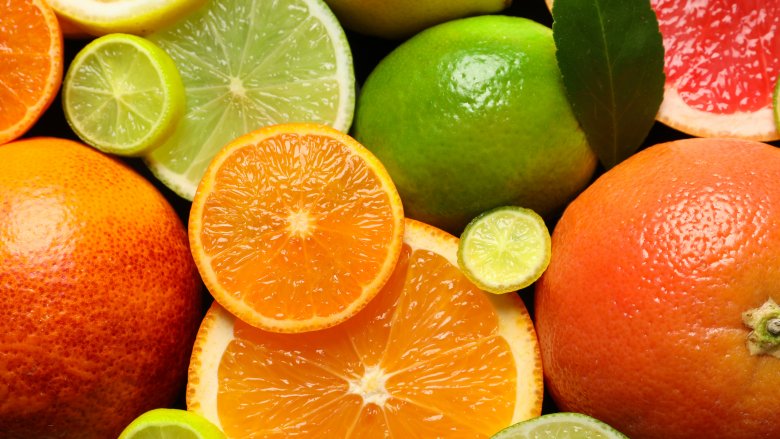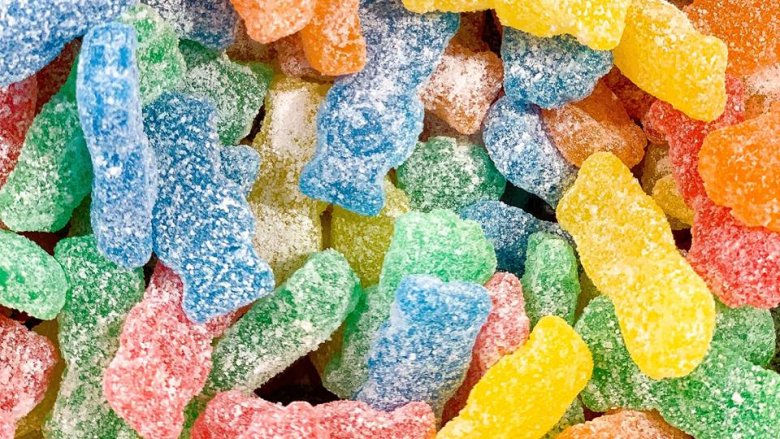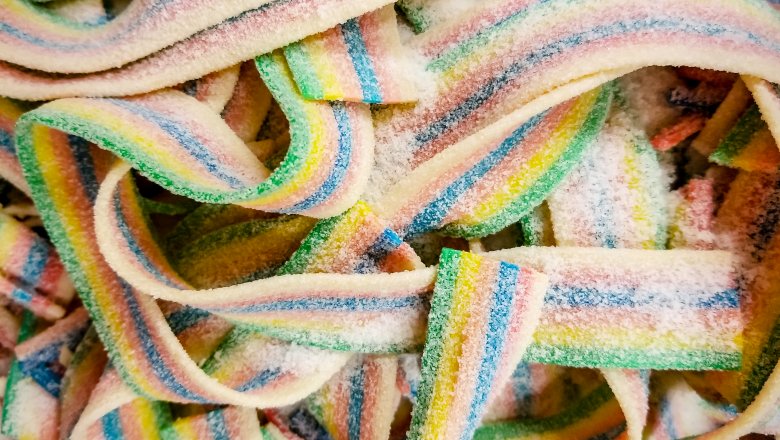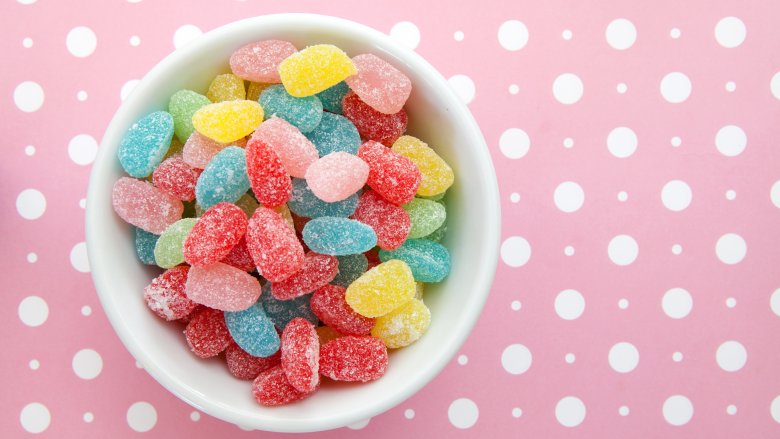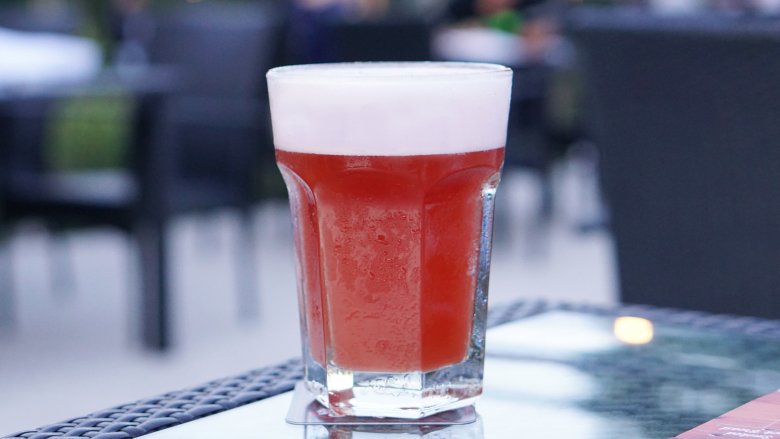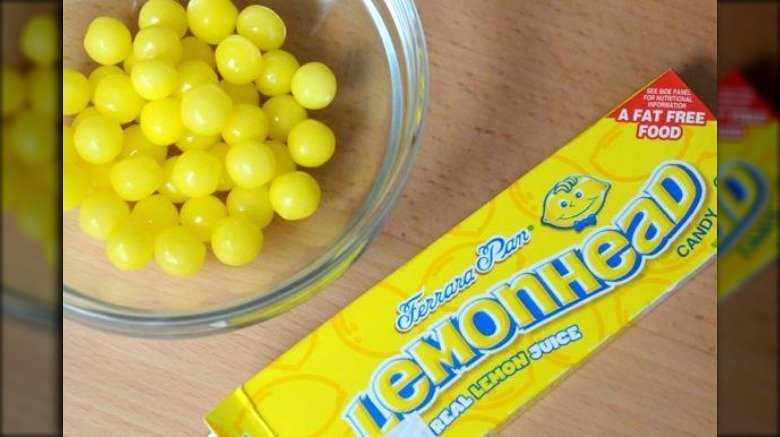What Really Makes Sour Candy Sour?
If you've ever popped a Warheads candy in your mouth or snacked on a handful of Sour Patch Kids, chances are you've experienced the rush and the zing of sour candy. It's the feeling we all love to hate, and for some, that mouth-puckering taste is so craveable that it's the only type of candy they'll eat. It's the ideal balance of fruit and tart.
The candy industry sells over five million pounds of candy each year in the U.S. alone, and sour candy makes up a sizeable portion of that. There seems to be enough people out there who love to feel the burn of sour candy, and it definitely takes a few extra steps in the manufacturing process to produce those eye-popping sour treats.
But what exactly is the process that makes these candies so sour? How do they get that infamous sandy coating? We decided to take a closer look. This is what really makes sour candy sour.
Sour candy is sanded with an acidic coating
Sour candies are typically made by adding an outside coating to a fruit-flavored candy product. This method is the reason why when you bite into a piece of Sour Patch Kids candy, or a Sour Punch Straw, you get that sweet sensation with a bit of pucker all at the same time.
According to Univar, incorporating sour flavors directly on the surface helps deliver the super-sour flavor consumers want, and manufacturers are using more acid to make it happen. "To accomplish increased sourness, manufacturers are sanding the outer surface of candy with acid or acid-containing blends..." they reported. "Typically, acid is added as part of a dry-mix for sanding."
According to Livestrong, most sour candies incorporate one or more types of acids. Citric acid, malic acid, tartaric acid, and fumaric acid are the most common choices, but there may be other types incorporated depending on the candy and the flavor goal. Because difference acids add a different level of sourness, manufacturers carefully select an acid mixture to create the perfect recipe.
Most sour candies contain citric acid
Although sour candies use a number of acids to get their mouth-puckering flavor, citric acid is one of the most prevalent. According to Livestrong, citric acid is found in lemons, limes, grapefruits — essentially all citrus fruits. As citric acid gets its name from citrus fruits, which generally offer that tartness we all have a love/hate relationship with, it only makes sense why it would be incorporated into sour candies.
According to Wired, there's a chemical process that comes into play when citric acid is used in sour candies. "Like all acids, citric acid yields hydrogen ions that activate the tongue's sour taste receptors," they said.
Citric acid is naturally found in citrus fruits, but to utilize it in candies it must be commercially produced. According to Livestrong, this is accomplished by fermenting sugar with microorganisms, creating one of the most popular ingredients to utilize not only in sour candies, but as an additive in other foods, supplements, and even cleaning products.
The prolonged flavor of sour candy is thanks to malic acid
If you've sucked on a sour Warheads candy, you know that it hits you once, hits you twice, and then the sour flavor just keeps going. There's a persistence to sour candies, and that's all intentional. According to Wired, malic acid is introduced to the mix exactly for that long-lasting reason. "To prolong the pucker, malic acid is coated with hydrogenated palm oil, which likely acts as an invisible time release mechanism," they said. "As the oil melts, it releases hits of malic acid."
Malic acid can be naturally found in apples, apricots, cherries and tomatoes, so it's more of a mellowed tart flavor. But according to Livestrong, part of its role in sour candies is to boost the intensity of the sour and enhance fruit flavors at the same time.
Coincidentally, malic acid is also prevalent in skin care products, noting the potential for it to reduce signs of aging or assist in the treatment of acne. Maybe rubbing sour Warheads on your face can now be considered your new skin care regimen?
Sour candy has a low PH Level
Part of the reasoning our taste buds react to sour candy is because of its pH level. The term pH level comes from the very definition of the term — power of hydrogen. An item's pH level is based on the level of acidity it has. According to ThoughtCo, the pH scale is a logarithmic scale, meaning it runs from 1 to 14, and each number along the scale specifies a different rate. "Each whole pH value below 7 (the pH of pure water) is ten times more acidic than the higher value and each whole pH value above 7 is ten times less acidic than the one below it," they said. "So, a strong acid may have a pH of 1-2"
According to Foodbeast, acidic sour candies have a pH level comparable to battery acid. As it turns out, any tangy candy will typically have a pH around a 3 or a 2.5 on the scale, while sour candies measure around 1.8. But Warheads Sour Spray wins the crown as it comes with a 1.6 pH level. The pH for battery acid is 1, just shy of the Warheads brand, so it's no wonder the acidity in sour candies causes our eyes to widen.
Our taste buds recognize sour candy
A big reason we're prone to enjoying the zing from sour candy is all thanks to our taste buds. According Women's Day, adults have an average of 2,000 to 10,000 taste buds, which are located on your tongue, as most people recognize, but they're also found on the roof of your mouth all the way to your throat.
These receptors can recognize four main tastes including sweet, salty, bitter, and of course, sour.
According to Kids Health, when a human chews food, candy, gum, etc., the chemicals in that item are released and they trigger the olfactory receptors in the nose. Your taste buds and those receptors work together to create that flavor experience. Those chemical receptors also tell your brain all about it. Once your brain is on in the act, it releases serotonin to help you understand that what is in your mouth is, in fact, sour (and delicious).
Some sour candies use the same ingredients as sour beer
If you've ever had a sour beer, you've most likely consumed a beverage with lactic acid. And that same ingredient is incorporated into some sour candies.
According to Home Brew Talk, lactic acid is found in sour beers, along with some dairy products like yogurt and buttermilk. Brewers utilize different techniques to introduce lactic acid in beer, leading to the perception of sourness in the beverage. Some methods include just adding lactic acid into the beer when it's bottled, but others utilize it in the brewing process to complement or enhance a sour beer's flavor.
According to Univar, lactic acid is a bit more of a lingering acid, with a more mild flavor, and it's often used in sour candies for balance, similar to how it's used for sour beers. "Acids like fumaric, malic and lactic may linger longer depending on other formulation parameters. These attributes could be helpful with sweeteners and flavors to balance the overall taste profile." they said.
Sour candies really aren't that old
Sour candies, especially the extremely sour variety that's popular today, are still relatively new in comparison to all of the many other selections on the candy market. And that was due in part to not wanting to spook the consumer. According to NPR, mass-manufactured candy, specifically in the 19th century, had a bit of a bad rap. "Confectioners had to contend with worries that cheap sweets contained harmful chemicals or were made under filthy conditions," they said. For that reason, the last thing candy manufacturers wanted to do was brand themselves as strange or dangerous — even if it was meant as a joke. Warheads and Toxic Waste were names that would fly.
Eventually, Halloween candy began to break the industry out of that mold by introducing ghoulish treats, but it wasn't until Atomic Fire Ball, introduced in 1954, that pain-staking candy became known in the U.S. According to NPR, the long-lived Lemonhead candy was introduced in 1962, utilizing citric acid that mimics that sour lemon flavor, and consumers responded.
However, it wasn't until 1993 that the super sour craze truly made it on the market with Warheads. "It was brought to these shores by Peter De Yager, founder of the Foreign Candy Co.," said NPR. "He realized he had a potential hit on his hands. De Yager traveled through East Asia, ground zero for extra-sour candy, sampling local varieties of sourness, before finding the sourest one of all in Taiwan."
